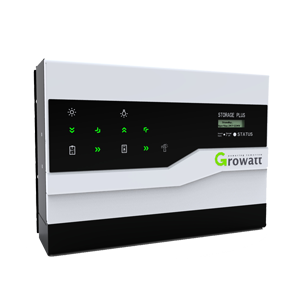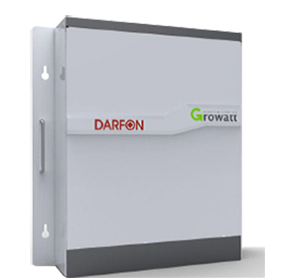

SP2000 Energy Storage System
The SP2000 Energy Storage System stores excess renewable energy power in a Lithium battery storage pack, giving around 4kw of power which can be drawn when the PV panels are not generating. This simple system can be retrofit to most standard Solar PV installations.
This system is a single MPPT tracking system only and is not compatible with micro-inverters or optimisers. Attention must be paid to compatibility of any inverters including voltage parameters. If necessary check compatibility.
The Lithium Battery Pack is 2 x 48HA 52v batteries in a single cabinet. This battery management system gives a total capacity of 5kw of which 80% can be drawn (you cannot 100% empty a battery) leaving 4kw available. The battery pack has its own inbuilt battery management system which manages the usage, temperature and performance of the batteries to retain the best lifetime performance possible. This battery pack is installed close to the Controller unit and is connected by 2 cables – one for communication and one for transferring the power.
The Sensor clamps on to the AC supply to the property. This then provides the information as to the flow of electricity in and out of the property, allowing the Controller to manage the newly generated DC power. The Sensor is connected vial an RJ45 cable which has a range of up to 25m, so attention is necessary when surveying an installation to ensure that access is possible for the sensor. Attention must be paid to the arrow on the Sensor which indicates the correct position for installation, putting it in the wrong way around will risk reverse information.
- SP2000 Storage System Datasheet – Growatt SP2000 Datasheet
 (Click to View)
(Click to View) - SP2000 Battery Installation Guide – SP2000 Battery Installation Guide
 (Click to View)
(Click to View) - SP2000 Installer Tips – SP2000 Installer Tips
 (Click to View)
(Click to View) - SP2000 Battery Warranty Card – Battery warranty Card
 (Click to View)
(Click to View)
How the SP2000 works
How Growatt Storage System SP2000 Works  (Click to View)
(Click to View)
The Growatt SP2000 Storage System stores DC electricity straight from the PV panels into a Lithium battery storage pack. The Growatt SP2000 Storage System solar battery storage has a useable capacity of 4kw from fully charged. As renewable energy PV power is generated throughout daylight, the controller manages the available renewable energy power and ensures the most efficient use of the PV generated power. Priority is given to the property demands, with the Lithium battery storage being prioritised next and lastly the power will be exported to the grid.
EVEN THE STORED ELECTRICITY STILL GOES THROUGH THE GENERATION METER, so you are still paid for it, the renewable energy power simply comes from the solar battery storage as it is required instead of instantly as it is generated.
The system does not know if it is daylight or not, so on the occasion that it is during the day but there is low renewable energy generation from the PV but the house requires power, the solar battery storage will still discharge available power from the battery store.
Single MPPT Tracking
The Growatt SP2000 Storage System controller is designed to accept multiple string input into the solar battery storage, but only on a single MPPT installation.
Where you have single or double string single tracking installations, you can put one or both of the string inputs into the inverter. This means that if you have Dual Tracking ( 2 MPPT) which is generally used for split installations such as East and West , or an odd number of panels per string, such as 9 and 6 panels, you can only use one of the strings for the solar battery storage. For more clarification or guidance contact your distributor.
The Growatt SP2000 Storage System
There are 3 main parts to the Growatt SP2000 Storage System - The Controller, the Lithium Battery pack, and the Sensor.
The Controller can manage PV renewable energy installations from 2-8kw in total. The more renewable energy PV on the installation, the more residual power will be available to charge the Lithium Battery pack, which is a battery management system. The Controller monitors the level of renewable energy power being supplied by the PV panels, and the level of flow in and out of the property. The Controller requires a standard AC supply to plug into, so this must be considered when surveying and installation.
The Controller will prioritise the demands of the property first, then allocate any residual power to the battery management system, filling the batteries of the solar storage system, and the last thing it will do is to export to the grid. Often you will have a combination of these functions going on – power to the house, excess to the battery management system, with residual going to the grid.
The controller has an interface panel which allows you to see the status of the system at any time. There is also an LCD display screen which allows you to access a range of real-time data.
The Lithium Battery Pack is 2 x 48HA 52v batteries in a single cabinet. This battery management system gives a total capacity of 5kw of which 80% can be drawn (you cannot 100% empty a battery) leaving 4kw available. The battery pack has its own inbuilt battery management system which manages the usage, temperature and performance of the batteries to retain the best lifetime performance possible. This battery pack is installed close to the Controller unit and is connected by 2 cables – one for communication and one for transferring the power. The Lithium Battery Pack will be fully charged in 2 ½ hours by 2 kw of Solar PV power.
The Sensor clamps on to the AC supply to the property. This then provides the information as to the flow of electricity in and out of the property, allowing the Controller to manage the newly generated DC power. The Sensor is connected vial an RJ45 cable which has a range of up to 25m, so attention is necessary when surveying an installation to ensure that access is possible for the sensor. Attention must be paid to the arrow on the Sensor which indicates the correct position for installation, putting it in the wrong way around will risk reverse information.
Installation
As with all installations a good survey will help with the efficiency of installation.
The Growatt SP2000 Storage System Controller unit is installed between the PV panels and the inverter. They most likely installation location is close to the inverter, alternatives are possible. Limiting installing long additional runs of DC cable will maintain efficiency of the overall installation.
As shown in the installation manual, the string inputs can go directly into the controller (via MC4 connections) and then new cables are used to take the connection from the controller as it was previously.
The controller requires an AC standard plug supply, and an RJ45 cable needs to run from the controller to the AC supply to the property – these are the main variables for the installation.
The Lithium Battery pack weighs 45kg, so forward thinking to lift it up to its final installation position is sensible.
This is not a complicated installation. A clear survey will minimise the amount of time required. It is a 2 man job to lift the battery pack into place, however all other areas of the installation are achievable by a single installer.
Monitoring the Growatt SP2000 Storage System performance
The Growatt SP2000 Controller Unit has a display on the front. This display will show the status of the Growatt SP2000 Storage System at all times. By following the arrows you can see where any power is moving around the system.
If you have a wireless router in the property you can use a Wifi Dongle which is installed into the controller and will remotely link to an online monitoring platform which will allow full information as to the daily weekly and monthly performance of you energy back up system. If you have I phone then you can access this information through an ‘Phone App’ straight to your phone.
F.A.Q.
Q:Does this work in a power cut?
A: The Growatt SP2000 battery storage system is a means of saving renewable energy from Solar PV panels via a battery management system and creating a solar battery back up. The power is supplied to the battery storage as DC power. ThSP2000 is not an inverter storage battery, it is not inverter integrated. Therefore the rules of G83 still apply to the inverter which means that it will switch off if a power cut is detected.
Q:Is the system Dual Tracking
A: No, the SP2000 battery management system cannot take renewable energy inputs from uneven inputs such as east and west arrays, or odd numbers of panels on the string inputs. The SP2000 has multiple string input – so if you have 2 strings of 7 etc. all on the same orientation, then the generated renewable energy can be input into the solar battery storage.
Q:How much electricity will I save?
A: The SP2000 battery storage system has a gross capacity of 5kw, which is Net 4kw (80% discharge on the lithium battery pack). However the amount of renewable energy you will save depends on 2 important factors. Firstly the amount of PV power you have available – ie is it a 3kw or a 4 kw installation – how much household usage do you have – if you are using a lot of power then you will have less residual power to fill the batteries. The battery storage system has spare power diverted by the battery management system. It therefore depends on how much spare power is generated. There is no fixed answer, but data of other installations can be requested to give examples of savings.
Q:How much power is needed to charge the solar battery storage unit?
A: The Lithium Battery pack will charge in around 2 ½ hours from a supply of 2kw. If the renewable energy supply can provide 2kw of constant power via the battery management system to the battery storage then the batteries can fill quickly. One of the major benefits of Lithium batteries in the solar battery backup system is that it charges quickly.
PV TILE SYSTEM ENQUIRY
Call us on
+44 (0) 8444 930088